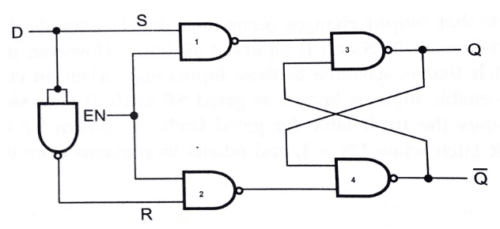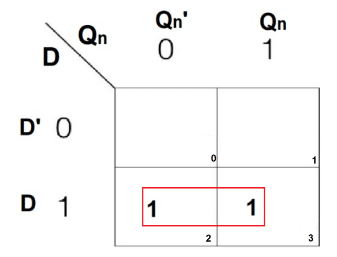D Flip flops or data flip flops or delay flip flops can be designed using SR flip flop by connecting a not gate in between S and R inputs and tying them together. D flip flops can be used in place of SR flip flops where you need only SET and RESET state.

Also Read: Different Types of Flip Flops in digital electronics
D Flip Flop Working
Let us look at the possible cases and write it down in our truth table. The clock is always 1, so only two cases are possible where D can be high or low.
Case 1: D = 0
Gate 1 = 1, Gate 2 = 0, Gate 4 / Q(n+1)’ = 1, Gate 3 / Q(n+1) = 0
Note: Since one input of Gate4 is 0 and Gate4 is a NAND gate. Irrespective of the other input, the output of Gate 4 will be 1 as per the property of NAND gates.
Case 2: D = 1
Gate 1 = 0, Gate 2 = 1, Gate 3 / Q(n+1) = 1, Gate 4 / Q(n+1)’ = 0
Note: Since one input of Gate3 is 0 and Gate3 is a NAND gate. Irrespective of the other input, the output of Gate 3 will be 1 as per the property of NAND gates.
Now let us write the truth table-
D Flip-Flop Truth Table
| CLK | D | Q(n+1) | State |
| – | 0 | 0 | RESET |
| – | 1 | 1 | SET |
We will use this truth table to write the characteristics table for the D flip-flop. In the truth table, you can see there is only one input D and one output Q(n+1). But in the characteristics table, you will see there are two inputs D and Qn, and one output Q(n+1).
From the logic diagram above it is clear that Qn and Qn’ are two complementary outputs that also act as inputs for Gate3 and Gate4 hence we will consider Qn i.e the present state of Flip flop as input and Q(n+1) i.e. the next state as output.
After writing the characteristic table we will draw a 2-variable K-map to derive the characteristic equation.
| D | Qn | Q(n+1) |
| 0 | 0 | 0 |
| 0 | 1 | 0 |
| 1 | 0 | 1 |
| 1 | 1 | 1 |

From the K-map you get 2 pairs. On solving both we get the following characteristic equation:
Q(n+1) = D
D Flip Flop Advantages
There are several advantages to using a D flip-flop. Some of them are listed below:
- Single input: The D flip-flop has a single data input, which makes it simpler to use and easier to interface with other digital circuits.
- No feedback loop: The D flip-flop does not have a feedback loop, which eliminates the possibility of a race condition and makes it more stable than other types of flip-flops.
- No invalid states: It does not have any weak states, which helps to avoid unpredictable behavior in digital systems.
- Reduced power consumption: The D flip-flop consumes less power than other types of flip-flops, making it more energy efficient.
- Bi-stable operation: Like other flip-flops, the D flip-flop has a bi-stable operation, which means that it can hold a state indefinitely until it is changed by an input signal.
Limitations of D Flip Flop
Apart from several advantages, there are some limitations associated with D flip-flops. Some of them are listed below:
- No feedback: The D flip-flop does not have a feedback path, which means that it cannot be used for applications that require feedback control, such as servo systems or motor control.
- No toggling: It cannot be used for toggling applications since it only responds to the data input and not to the clock signal.
- Propagation delay: It has a propagation delay, which can lead to timing issues in digital systems with tight timing constraints.
- Limited scalability: The D flip-flop can be challenging to scale up to more complex digital systems, as it can lead to increased complexity and the potential for errors.
D Flip-Flop Applications
Some of the applications of D flip flop in real-world includes:
- Shift registers: D flip-flops can be cascaded together to create shift registers, which are used to store and shift data in digital systems. Shift registers are commonly used in serial communication protocols such as UART, SPI, and I2C.
- State machines: It can be used to implement state machines, which are used in digital systems to control sequences of events. State machines are commonly used in control systems, automotive applications, and industrial automation.
- Counters: It can be used in conjunction with other digital logic gates to create binary counters that can count up or down depending on the design. This makes them useful in real-time applications such as timers and clocks.
- Data storage: D flip-flops can be used to store temporary data in digital systems. They are often used in conjunction with other memory elements to create more complex storage systems.








